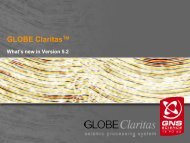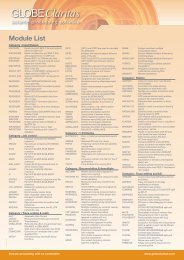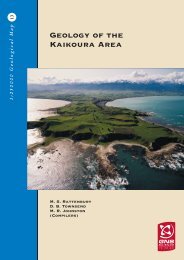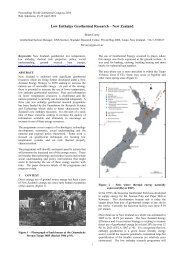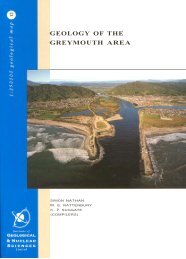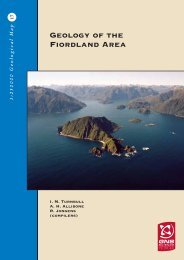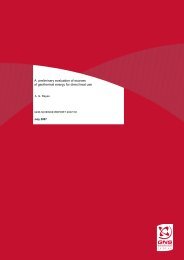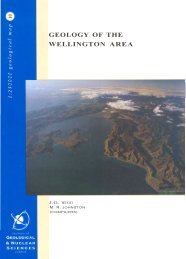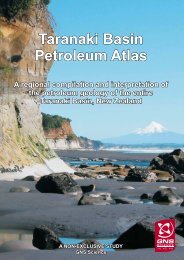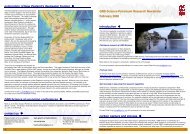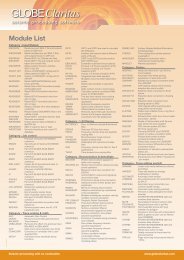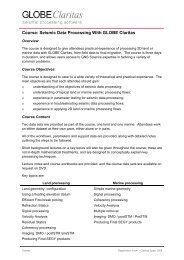GEOLOGY OF THE - GNS Science
GEOLOGY OF THE - GNS Science
GEOLOGY OF THE - GNS Science
You also want an ePaper? Increase the reach of your titles
YUMPU automatically turns print PDFs into web optimized ePapers that Google loves.
Figure 22 Chevron folds inwell bedded Wha ngaiFormation mudstones on thebank of Waimatau Stream(Y l 61382235). The directionof younging is to the right andthe folds are overturned. Thisstyle and intensity of folding,invotving shallow dipping axialplanes, is common within theEast Coast Allochthon.at Wairamaia Stream (near East Cape) and at Mahi a(Moore I988b). The Upper Calcareous Member is about500111 Lhick in the reference section at Te Weraroa Stream(Y I6/3 17 197); the total stratigrap hic thickness of theWhangai has been estimated to be as great as 900 m(Moore 1988b) but there may be undetected structuralrepetition.Whangai Fonnation within the allochthon is conformablyoverlain by up to 50 m of very poorly bedded, grey tobrown-black, moderately soft to hard , noncalcareousmudstone of the Waipawa Formation (Piw). Only onearea is large enough to show on the 1:250 000 map: inthe upperWaipaoa va lley Whangai Formation includes athrust sliver of Waipawa mudstone which can be tracedlateraliy for c. 5 km (Mazengarb e1" I. 199 1a).Eocene and Oligocene sedimentary rocksEocene to Oligocene rocks present with in the East CoastAllochthon are similar to equivalent rocks in the in-placesequence and are incl uded in the same lithostratigraphicunit (Mangatu Group). Wanstead Forma tion (Egw)conformably overlies Waipawa Formation and consistspredominantly of pale grey-green calcareous mudstone.in places with intercalated beds ofmid to dark green (redbrownwhen deeply weathered). glauconitic and lithicsandstones. A few sandstones are up to 20 m thick andsome are well cemented by calcium carbonate. At PortAwanui (Z 15/89760 I) the format ion showsintraformational slump fo lding. and conglomerate andpebbly mudstone contain clasts of Waipawa Formationup to 3 m across. Coloured (red-brow ll , white, greengrey)calcareous and noncalcareous. smectitic clays tonewith thin, fi ne-grai ned, glauconitic sandstone beds is adisti nctive facies. common in areas of melange withinthe East Coast Al lochthon and in some structura llycomplex areas of me lange and d iap irs beyond theallochthon front. Wanstead Formation is apparently lipto 300 111 thick. The known age ra nge is Late Paleoceneto Eocene (Te urian- Run angan), as for Wa nsteadFormation within the in-place sequence.The conformably overl ying Weber Forma tion (Ogw)consists of up to 900 m of poorly bedded, pale greycalcareous mudstone with thin , glauconitic sandstonebeds and muddy limestone. In the Mangatu area limestoneis up to 500 m thick. Foraminifera indicate the WeberForm ati on is mainl y of Oli gocene (Whai ngaroanWaitakian) age.MIOCENE AND PLIOCENE ROC KSBoth the Earl y Cretaceous 10 O ligocene in-place sequenceand the East Coast All ochthon are unconform ablyoverlain by a structurally simple sedimentary sequenceof Earl y Miocene to Pliocene age (Stoneley 1968: Mooreel/ll. 1989: Mazengarb e1 /II. 1991 a). The unconformitymarks a pronounced change in the e nvironment ofdeposition. The underlyi ng Mangatu Group is mainlyclay-rich pelagic mudstone and limestone. whereas theoverlying Earl y Miocene rocks are terrigenous and muchth icker, contai ning sequences of massive blue-greymudstone. alternatin g centimetre- to metre-beddedsandstone and mudstone. and massive sandstone, withlesser conglomerate and tuff. Emplacement of the EastCoast All ochthon. a nd th e subseque nt c ha nges insedimentation and deformation style, are consequencesof a major tectonic event associated with the onset ofsubduction at an acti ve plate boundary between Northland26



